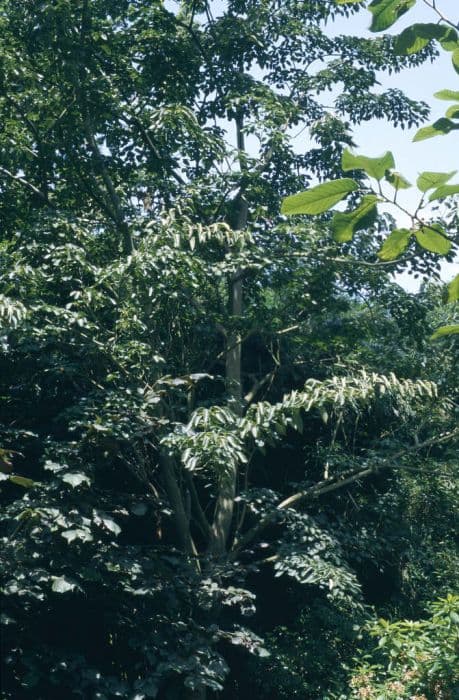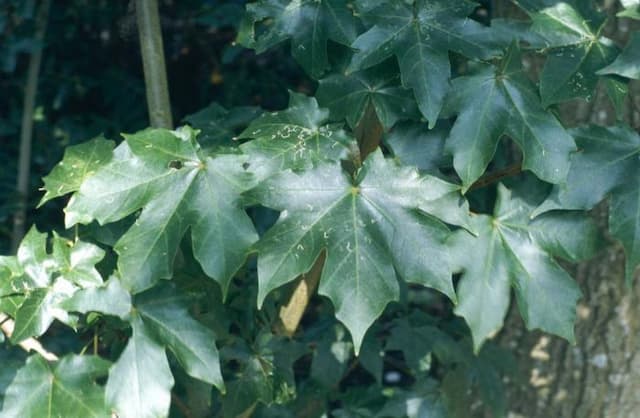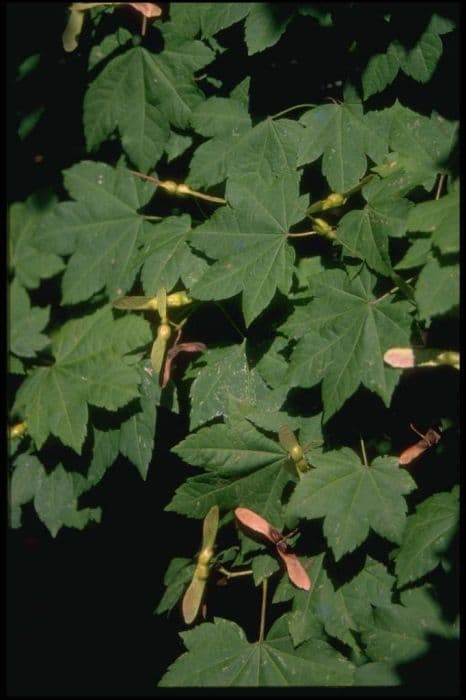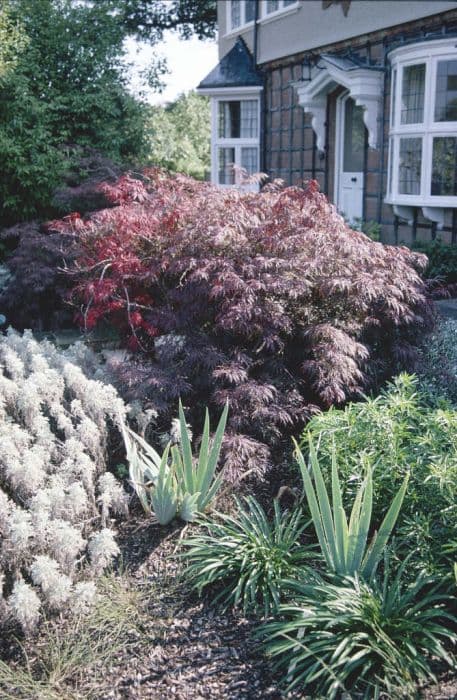Japanese Maple Shirazz Acer palmatum 'Shirazz' (P/v)
ABOUT
Acer palmatum 'Shirazz' is a captivating variety of Japanese maple that boasts a unique combination of foliage colors and patterns. This plant presents an ever-changing palette throughout the growing season. The leaves have a striking coloration, often starting with a burst of rich reddish-pink with white margins in spring. As the leaves mature, they transform into a breathtaking display of variegated green, cream, and pink hues. The leaves of 'Shirazz' are deeply lobed, following the typical Japanese maple fashion, with each leaf comprising five to nine pointed lobes, creating a delicate and complex silhouette that resembles an artistically cut paper pattern. The texture of the leaves is smooth with a fine, almost velvety quality that catches the light, creating different visual effects depending on the angle and intensity of the sunlight. As autumn approaches, 'Shirazz' provides a final show of color when the leaves take on vibrant tones of crimson and scarlet, mixed with the cream-colored variegations. This bold autumnal change adds a warm and inviting presence to any garden space. The bark on the tree is another subtle feature, typically a soft grey or light brown that provides a gentle contrast to the brilliance of the leaves. Blooming in the spring, 'Shirazz' may display small, inconspicuous reddish-purple flowers, which can add an additional layer of interest to the plant, although it's the foliage that truly captures the attention. The graceful, branching structure of 'Shirazz' Japanese maple provides an open, airy feel in the garden, allowing light to pass through and creating dappled shade beneath. This attribute makes it an excellent plant for layering and adding depth to a garden design, without dominating the landscape.
About this plant
 Names
NamesFamily
Sapindaceae
Synonyms
Japanese Maple, Shirazz Japanese Maple
Common names
Acer palmatum 'Shirazz'
 Toxicity
ToxicityTo humans
The Japanese Maple, specifically the Acer palmatum 'Shirazz' variety, is generally not considered toxic to humans. Ingesting parts of this plant is unlikely to cause poisoning or severe symptoms. However, as with any non-food plant, individual sensitivity or allergic reactions could occur, and it is always advisable to avoid ingestion of ornamental plants.
To pets
The Japanese Maple, including the 'Shirazz' variety, is also considered non-toxic to pets. Dogs and cats that ingest parts of this plant are unlikely to experience serious symptoms of poisoning. Nevertheless, pets can sometimes have unpredictable reactions or may choke on plant material, so it is wise to prevent them from chewing on decorative plants.
 Characteristics
CharacteristicsLife cycle
Perennials
Foliage type
Deciduous
Color of leaves
Variegated
Height
15 feet (4.57 meters)
Spread
15 feet (4.57 meters)
Plant type
Tree
Hardiness zones
5
Native area
Japan
Benefits
 General Benefits
General Benefits- Aesthetic Appeal: The Japanese Maple 'Shirazz' offers visually striking foliage with a unique color palette that changes through the seasons.
- Landscape Versatility: Adaptable to a variety of settings, this tree can serve as a focal point or complement other plants in gardens and landscapes.
- Compact Size: With a smaller stature, it fits well in residential yards and gardens where space might be limited.
- Cultural Significance: The Japanese Maple is often associated with peace and serenity, bringing a sense of tranquility to a garden setting.
- Wildlife Support: The tree provides shelter and food for birds and other wildlife, contributing to local biodiversity.
- Shade Provision: In the summer months, its canopy can offer a cooling shade to underplantings and garden visitors.
- Low Maintenance: Once established, it requires minimal care beyond regular watering and occasional pruning, making it suitable for gardeners of all skill levels.
- Seasonal Interest: It offers year-round interest from the emergence of spring leaves, to vibrant autumn colors, and the architectural form of bare branches in winter.
 Medical Properties
Medical PropertiesThis plant is not used for medical purposes.
 Air-purifying Qualities
Air-purifying QualitiesThis plant is not specifically known for air purifying qualities.
 Other Uses
Other Uses- Photography backdrop: Acer palmatum 'Shirazz' provides a stunning backdrop for photographers, particularly in autumn when its leaves turn vivid shades of red and purple.
- Bonsai: This plant can be trained as a bonsai, offering enthusiasts a chance to appreciate its beauty in miniature form.
- Education: Horticultural schools and botanical gardens use Acer palmatum 'Shirazz' for teaching about ornamental plant cultivation and maintenance.
- Art inspiration: The striking colors and forms of the 'Shirazz' Japanese maple can serve as inspiration for artists in various mediums such as painting and sculpture.
- Culinary decoration: While not edible, the leaves of the 'Shirazz' can be used as a decorative garnish for plating high-end cuisine, complementing the aesthetics of gourmet dishes.
- Feng Shui: In the practice of Feng Shui, placing a 'Shirazz' Japanese maple in the garden is believed to bring positive energy due to its graceful form and vibrant colors.
- Crafts: The leaves, especially when dried and pressed, can be used in crafting activities such as making bookmarks, greeting cards, or decoupage projects.
- Fall festivals: The 'Shirazz' variety is often showcased in autumn celebrations or fall festivals, where its foliage is a highlight among seasonal decorations.
- Cultural symbolism: In Japan, maple trees are associated with peace and serenity, making 'Shirazz' Japanese maple a popular choice for gardens intended to evoke these themes.
- Urban greening projects: 'Shirazz' Japanese maple is sometimes included in city greening projects for its aesthetic appeal and to enhance biodiversity within urban environments.
Interesting Facts
 Feng Shui
Feng ShuiThe Japanese Maple is not used in Feng Shui practice.
 Zodiac Sign Compitability
Zodiac Sign CompitabilityThe Japanese Maple is not used in astrology practice.
 Plant Symbolism
Plant Symbolism- Beauty and Elegance: With its unique foliage and color, the Japanese Maple 'Shirazz' represents beauty and elegance, symbolizing the aesthetic pleasures and the appreciation of visual beauty found in nature.
- Peace and Serenity: Often found in traditionally designed Japanese gardens, this plant is symbolic of peace and tranquility, invoking a sense of calm and meditative quietude.
- Endurance and Strength: The ability of the Japanese Maple 'Shirazz' to weather different seasons, especially its resilience during the cold winter, symbolizes endurance and the strength to withstand life's challenges.
- Balance and Harmony: The balanced growth habit and the harmonious shape of its leaves represent the ideal of living in balance with oneself and one's surroundings.
 Water
WaterJapanese Maple 'Shirazz' should be watered thoroughly when the top inch of soil feels dry, which may equate to once or twice a week, depending on the weather conditions. It is important to avoid waterlogging, so ensure proper drainage. Use approximately 2 gallons of water for each watering session during active growth in the spring and summer months. During the fall and winter, reduce the watering frequency as the plant enters dormancy. A general guideline would be to offer this amount of water every 7 to 10 days, adjusting as necessary for rainfall and temperature changes.
 Light
LightJapanese Maple 'Shirazz' thrives best in partial shade to filtered sunlight. Excessive direct sunlight, especially in hotter climates, can lead to leaf scorch, whereas deep shade can reduce the intensity of fall colors. The ideal spot for the 'Shirazz' variety is one where it receives morning sun and afternoon shade, thereby protecting it from the intense midday heat.
 Temperature
TemperatureJapanese Maple 'Shirazz' prefers temperatures ranging from 60 to 70 degrees Fahrenheit during the growing season. They can survive in winter temperatures down to about -10 to -20 degrees Fahrenheit. The ideal growing conditions for the 'Shirazz' maple would not exceed 80 degrees Fahrenheit as high heat can stress the plant.
 Pruning
PruningPruning Japanese Maple 'Shirazz' is necessary to maintain its shape, remove dead or diseased wood, and to promote healthy growth. Pruning should occur in late winter or early spring before new growth starts. Minimal pruning is often enough, focus on cutting back any crossing branches or shaping as desired. Late summer pruning is avoided to prevent stimulating new growth that won't harden off before winter.
 Cleaning
CleaningAs needed
 Soil
SoilJapanese Maple 'Shirazz' prefers well-draining soil with a slightly acidic to neutral pH, between 5.5 and 7.0. A mix of loamy soil, peat moss, and perlite or pine bark can provide good aeration and drainage. Mulching helps retain moisture and regulate soil temperature.
 Repotting
RepottingJapanese Maple 'Shirazz' should be repotted every 2-3 years or when it becomes root-bound. The best time to repot is in the early spring before the growing season starts.
 Humidity & Misting
Humidity & MistingJapanese Maple 'Shirazz' is adaptable but prefers moderate humidity levels. It does not require as high humidity as tropical plants; average room humidity is generally sufficient.
 Suitable locations
Suitable locationsIndoor
Provide bright, indirect light and protect from drafts.
Outdoor
Plant in filtered sun, protect from harsh extremes.
Hardiness zone
5-9 USDA
 Life cycle
Life cycleThe Japanese Maple 'Shirazz' begins its life as a seed, which requires stratification to break dormancy and germinate. Once germinated, the seedling sprouts and begins to establish its root system and initial leaves. As it enters the juvenile phase, the sapling grows more rapidly, developing its distinctive palmate foliage that exhibits varying colors from green to red and pink. The tree reaches maturity in several years and starts flowering and producing seeds, alongside further growth in height and canopy spread. Once mature, it can reproduce annually, creating a cycle of growth and reproduction over many years. As the tree ages, it may experience a decline in vigor, leading to reduced leaf size and color vibrancy before eventually reaching the end of its life span.
 Propogation
PropogationPropogation time
Early spring
The Japanese Maple 'Shirazz', a cultivar known for its striking variegated foliage, is typically propagated through grafting, which is the most popular method for this species. The optimal time to graft is in late winter or early spring before the buds break. In this process, a piece of the 'Shirazz' cultivar, known as the scion, is joined to a rootstock, usually from a more common or hardy Acer species. The scion, which is a 2 to 6 inch long stem piece with a couple of buds, is carefully trimmed at the base to expose the cambium. The rootstock is similarly cut to match and allow for a tight union. The two are then fastened together using grafting tape or rubber bands, and the junction is often sealed with grafting wax or a similar material to prevent drying and disease. Over time, the scion and rootstock will fuse, growing as a single plant with the desirable traits of the 'Shirazz' above the graft and the hardiness of the rootstock below.









